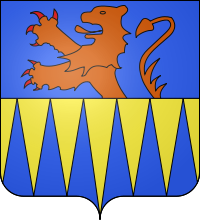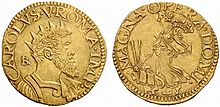- Prince or Princess Belmonte
-
Principate of Belmonte 
Creation date 1619 Created by Philip II of Spain Peerage Spanish Kingdom of Naples First holder Orazio Giovan Battista Ravaschieri Fieschi, 1st Prince of Belmonte Present holder Angelo Gennaro Granito Pignatelli, 13th Prince of Belmonte Remainder to Male-preference primogeniture Subsidiary titles Duke of Acerenza, Marquess of Galatone, Marquess of Castellabate, Count of Copertino Prince or Princess Belmonte (Principe o Principessa di Belmonte) is a noble title created in 1619 by the Spanish crown for the Barons of Badolato and Belmonte.
In addition to the princely title, the Princes were made Grandees of Spain, First Class in 1712, and in 1726 were granted the rank of 'Reichsfürsten', Princes of the Holy Roman Empire, with the title Serene Highness (Durchlaucht). The Princes hold a number of subsidiary titles, including Duke of Acerenza (1593), Marquess of Galatone (1562) and Count of Copertino (1562).
The seat of the princes is Palazzo Belmonte, on the Bay of Salerno and south of Amalfi, although the name of the senior title is taken from the fortress town of Belmonte, historically important for the defence of the Italian coast from Saracen invasion. Belmonte has been known since the Risorgimento as Belmonte Calabro.
The princes are descendants of the Fieschi family of Genoa,[1] who were ennobled [2] as Counts Palatine in the year 1010 by Henry the Holy, King of Italy and later Holy Roman Emperor. The Emperor created the title of Count of Lavagna and appointed the Fieschi as Imperial Vice Regents of all Tuscany and of the coast of Genoa.
Contents
Ancestry
The Princes of Belmonte descended from the Fieschi, Counts Palatine of Lavagna. The Fieschi were a one of the main families of Genoa, with the Grimaldi, Spinola and Doria. In the 13th century, the Fieschi were allied to the House of Grimaldi, modern day Princes of Monaco, in the struggle between the Guelphs and Ghibellines. The current prince is 35th in line from Frisco, 1st Count of Lavagna.[1]
The ancestors of the Belmonte Princes include Sinibaldo, Pope Innocent IV, and Ottobuono, Pope Adrian V, as well as several cardinals, a King of Sicily, the Viceroy of Naples under René I of Naples (Jacopo Fieschi), three saints including Saint Catherine of Genoa (1447–1510), and both generals and admirals of Genoa and other states. Through their later marriage to a line of the Pignatelli, the Princes of Belmonte share blood with a third pope, Pope Innocent XII, and the Jesuit Saint Joseph Pignatelli.
Ugone of Lavagna was alleged to have been the first to bear the name 'Fiesco' or Fieschi, attributed to his control of the fiscal affairs of the Holy Roman Emperor. His descendant, Rubaldo/Robaldo di Fiesco or 'Fieschi', was confirmed as Count of Lavagna in the 11th Century. In the mid 12th Century (c1158) Frederick I, Holy Roman Emperor 'Barbarossa' confirmed [3] feudal rights in Lavagna to the Fieschi: the beneficiaries included Rubaldo and his nephews Gulielmo, Tebaldo, Enrico, Ruffino, Aldedado, Gherardo; Ottone and his brother Ugone; and Alberto and his brother Beltramino. The rank of Count Palatine was confirmed once again at Lucca on 27 May 1369 by Charles IV, Holy Roman Emperor of the House of Luxembourg.[4] Later confirmations of the Fieschi status as direct vassals to the Holy Roman Emperor were given by the House of Habsburg in 1521, 1529, 1568, and 1620.
Beltramino Fieschi, 7th Count of Lavagna, was succeeded by his son Gerardo Fieschi, 8th Count, who was known as 'Gerardo Ravascherius'. Taking the name Ravaschieri Fieschi, this branch rose to greater prominence as royal bankers in the Kingdom of Naples: Giovanni Battista was appointed Master of the Mint of Naples and Aquila (Maestro di Zecca di Napoli e l'Aquila) in 1552 under His Imperial Majesty Charles V, Holy Roman Emperor (1516–1554), and his seal of 'IBR' frequently appears on the coinage of that time.[5] Giovanni Battista was one of 7 children, of whom the eldest brother Giovan Francesco, was Prior of Bari of the Order of Malta (died 1555). Germano followed his father as 'Maestro di Zecca', under King Philip II of Spain, and was the father of Giovan Battista, 1st Baron of Badolato, and therefore grandfather of Orazio, the first Prince Belmonte.
The princely title of Belmonte has descended to its present holder through the following houses: Ravaschieri Fieschi, Squarciafico Pinelli, and Pignatelli y Aymerich. The heiress of the last of these married the Marquess of Castellabate, uniting her lands and titles with those of the Granito family, patricians of Salerno (Seggio di Campo) since 1380.[6]
Residences
- Palazzo Ravaschieri Fieschi della Torre
- Palazzo Rivellino.
- Acerenza
- Castle of Galatone
- Copertino Castle
- Palace of Muro Leccese
- Palazzo Belmonte at Santa Maria di Castellabate
Notes
- ^ a b Lagomarsino, Isabella (2009). "Storia e dimore di una famiglia signorile tra Chiavari, Genova e Napoli". de Ferrari.
- ^ Federici, Federico (1645). "Della Famiglia Fiesca". Genova.
- ^ Bernabo, B. (Lavagna 18 December 1994, Chiavari 1998). "I Conti di Lavagna e l’alta Val di Vara". Atti del Convegno I Fieschi tra Papato e Impero: pp. 49–50.
- ^ von Frank. "Flisco (Fiesco)".
- ^ Olmos, Jose Maria de Francisco (2005). "The First Coins of Prince Felipe de Espana (1554-1556): Sovereign of Milan, Naples and England". Documenta & Instrumenta, 3 (2005) (Universidad Complutense de Madrid): pp. 155–186.
- ^ "Libro d'Oro della Nobiltà Italiana (XXII edizione 2000-2004)". Consulta Araldica del Regno d’Italia. September 2000.
See also
- Belmonte Calabro
- Castellabate
- Muro Leccese
- Acerenza
- Corigliano d'Otranto
- Galatone
- Argençola
- San Vicente
- Castellabate
- Copertino
- Badolato
- Veglie
- Leverano
- Rocca Cilento
- Santa Maria di Castellabate
Further reading
- Adels, Genealogisches Handbuch des, Fürstliche Häuser
- Ammirato, Scipione (1580, 1651), Delle famiglie nobili Napoletane, Firenze (2 volumes)
- Bernabo, B. (1994/1998), I Conti di Lavagna e l’alta Val di Vara, in Atti del Convegno I Fieschi tra Papato e Impero, ed. Calcagno, D., Lavagna and Chiavari Casa Ravaschiera
- Firpo, M. (1994/1998), La ricchezza e il potere: le origini patrimoniali dell’ascesa della famiglia Fieschi nella Liguria Orientale tra XII e XIII secolo, in Atti del Convegno I Fieschi tra Papato e Impero, ed. Calcagno, D., Lavagna and Chiavari
- Frank, Karl Friedrich von (1967–1975), Standeserhöhungen und Gnadenakte für das Reich und die österreichischen Erblande bis 1823, volumes I-V, Senfteneg
- Frank, Karl Friedrich von (1928), Alt-Österreichisches Adels-Lexikon, Vienna
- Ganducci, O. Famiglie nobili di Genova, secolo XVIII, ms. 94. Santa Margherita Ligure, Biblioteca Comunale
- Granito, Giacchino (1912), Memorie, notizie e docc. della Gente Granita, Napoli
- Ilari, Annibale (2001- Tipografica L. Palazzotti), I Gran Priori di Roma del Sovrano Militare Ordine di Malta
- Magri, Andrea (1640), Memorie della Nobilissima Famiglia Ravaschiera, Discendente da Gli'Antichissimi Conti di Lavagna
- Mediolani (1611), Antiquae Familie Scortiae, et Aliarum Comitum Lavaniae Antiquissima Monumenta
- Montefusco, Luigiantonio, Nobilta nel Salento Vol. III, Istituto Araldico Salentino, Lecce
- Musso, G.A. Stemmario p. 95
- Rietstap (1887), Armorial Général, 2eme Edition
- Rolland, V. H. (1926), Supplément à Rietstap
- Ruvigny, Marquis de (1914), The Titled Nobility of Europe
- Turchi, Gabriele (2004), Storia di Belmonte (Dalle origini alla fine del secolo XIX)
External links
Categories:- Spanish princes
- Lists of Spanish nobility
- Italian nobility
- Families of Genoa
- Papal families
- Counts of the Holy Roman Empire
- Knights of the Golden Fleece
Wikimedia Foundation. 2010.

